History of the Mediterranean Sea
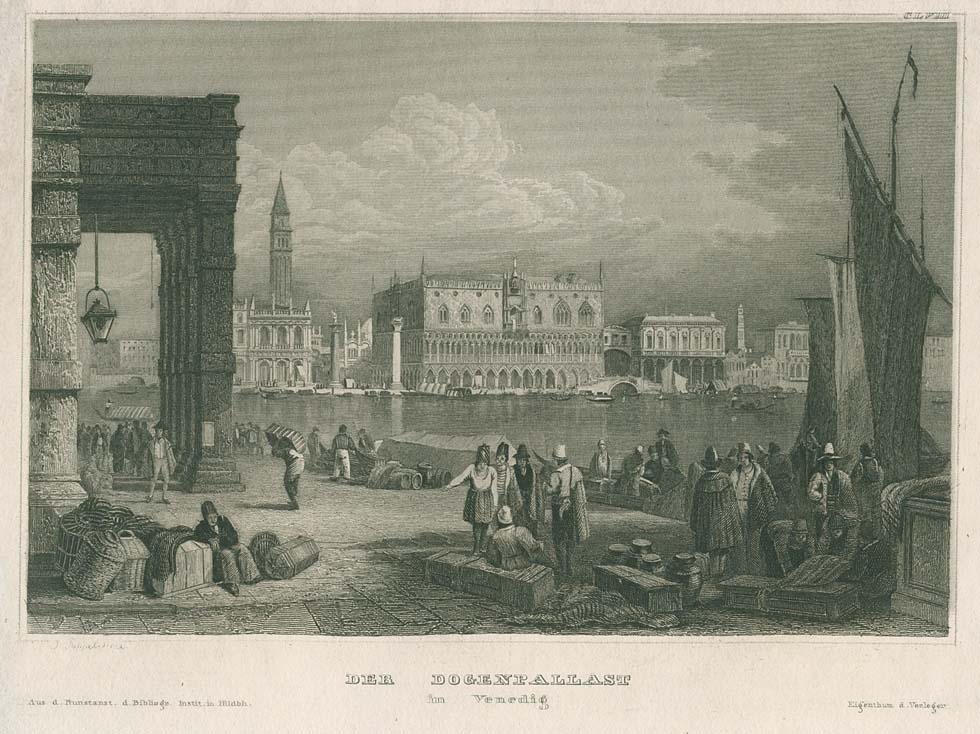
Venice (coll. Fritz Soelch)
As the greatest European inland sea, surrounded by three continents, Europe, Asia and Africa, the Mediterranean sea covers about 2.5 million sqkm. In the utmost west it is connected with the Atlantic Ocean through the Strait of Gibraltar, in the east through the Dardanelles (Strait of Galipoli, the antique Hellespont) with the Black Sea, and in the southeast by the Suez Canal and the Red Sea with the Indian Ocean. Since the remote antiquity, the "mare internum" has provided the base of a prosperous economic and cultural exchange between the people settling along its coasts and thus having the area made the cradle of the occidental civilization. One condition of this development has certainly been the favour of the mild climate, the other a skillful and highly efficient art of navigation, a necessity which no people could afford to neglect unless losing the influence and access to natural resources.
The proudest civilization has developed in Egypt and the pyramids are testifying it. Pictures of Egyptian ships have survived from as early as 4,000 years B.C. On the Nile they used sailing vessels which could be sailed up river against the stream. Men had soon found out that merchandise could easier be conveyed by ship than over land. About 1500 B.C., the kings of Crete have built up a fleet which helped the island kingdom to become the leading power of the eastern Mediterranean. Homer, the early poet and chronologist of antiquity, has delivered the first documented report on ship building, dating from the 6th century B.C. This art has gradually been perfected over the ages. By that time Athens had settled many shore-territories and had built up a well-organized trade system. Thanks to navigation, arts and civilization developed to the stunning high standard being found in Greece, Egypt and Italy.

Temple of Poseidon, Cape Sounion, Greece (WS)
In 480 B.C. a Greek naval force under Themistocles defeated the Persian fleet at Salamis, thus saving western culture. By the first century A.D., all territories surrounding the Mediterranean Sea had come under the brutal control of the Roman Empire. The prospering trade of the Romans however was increasingly disturbed by the growing piracy. The attacked merchant ships were deprived of their loads and the crews kidnapped for demanding ransom. The plague has grown to an extent, that the supply of the capital with cereals got endangered. It necessitated a task force of 12,000 foot-soldiers and 5,000 on horseback under the command of Gnaeus Pompeius to put it an end by capturing 1,300 vessels and destroying their hiding places in the year 67 B.C.
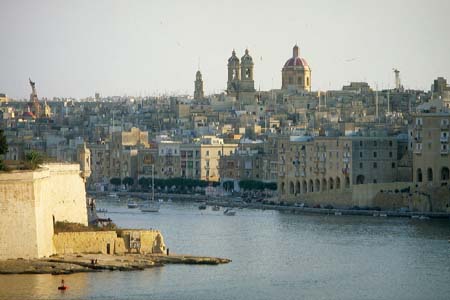
Grand Harbour of Valletta, Malta (WS)
|
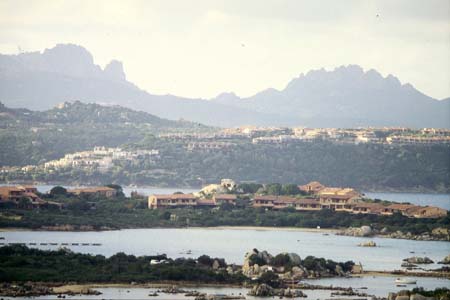
Sardinia, Costa Smeralda (WS)
|
What it had meant to cross the stormy Mediterranean Sea in late autumn at those times, a vivid report has been delivered by the Bible in chapter 27 of the Act of Apostles. It describes the transport of St. Paul, a disciple of Jesus Christ, as a prisoner from Caesarea to Rome via Cyprus and Crete, ending with the dramatic account of shipwrecking off-shore Malta in 60 A.D. After the separation of the Roman Empire in 395 A.D. into an eastern and a western reign, owing to religious strives within Christianity, the former capital lost her power to Germanic tribes which forced their way into Italy in the 5th century. Out of the Orient, the Islamic Arabs pushed ahead to the Maghreb, crossed in 711 the Strait of Gibraltar, made the Iberian peninsula a Califate and spread Muslim religion even to West Africa.
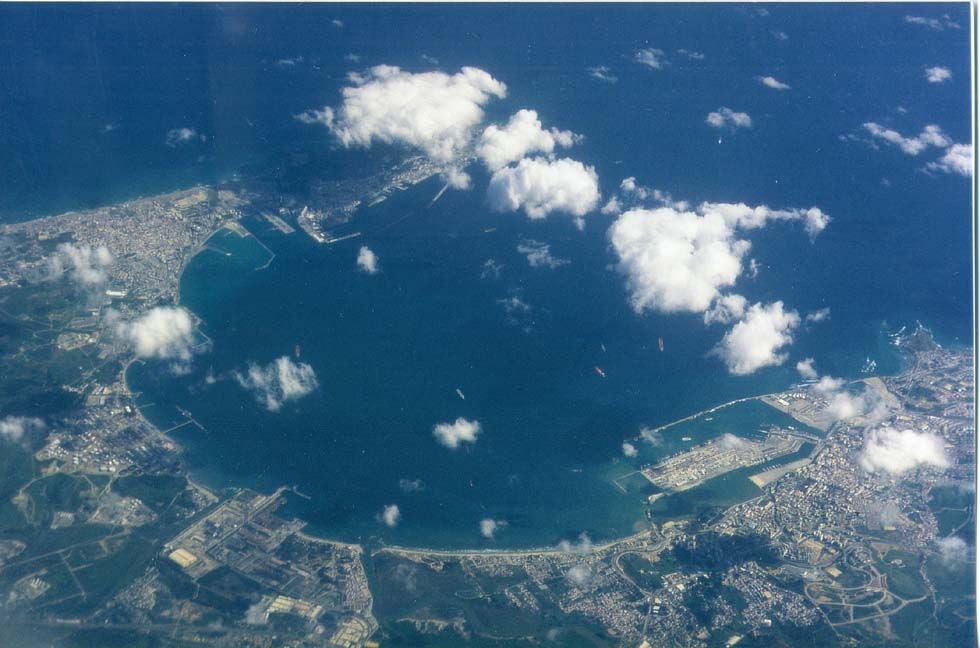
Gibraltar and Algeciras (WS)
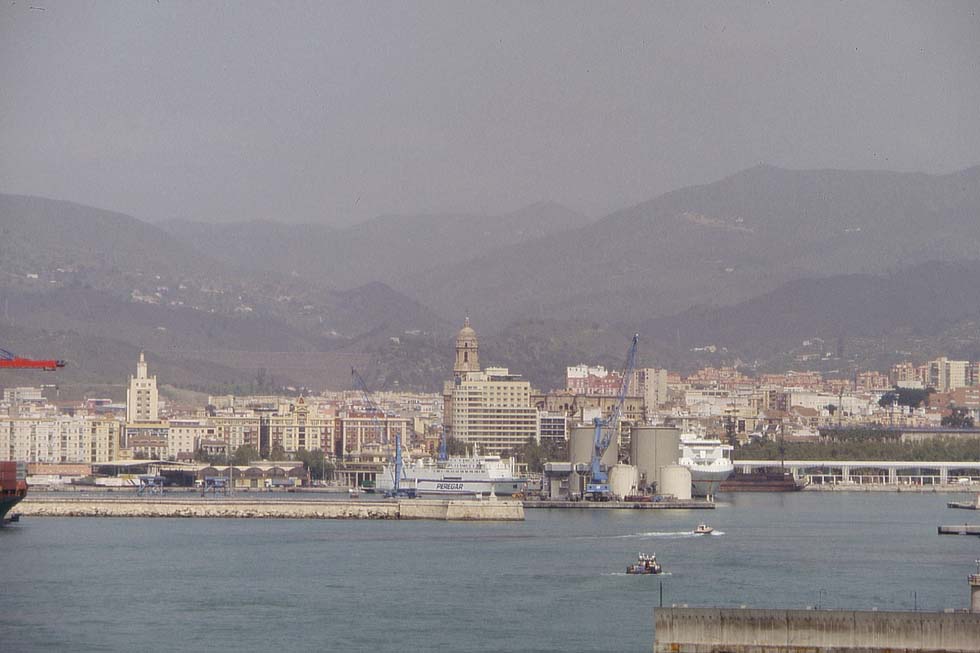
Malaga and a ro-ro of Peregar (WS)
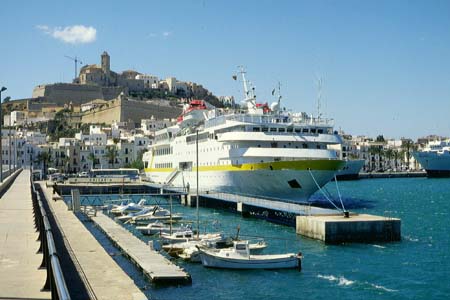
Ibiza and the "Vistamar" (WS)
|
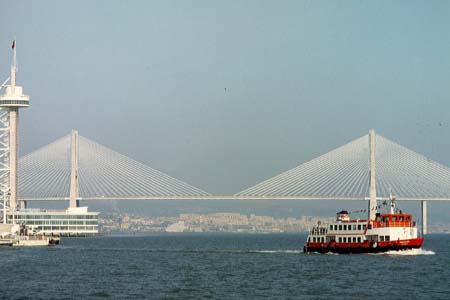
Lisbon, Expo center (WS)
|
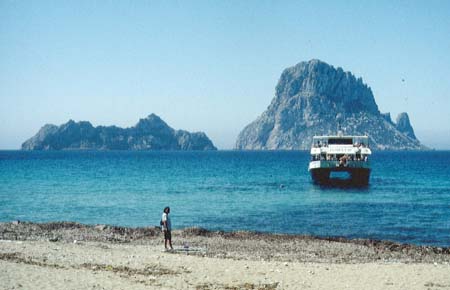 Ulises Cat at Ibiza coast (WS)
Ulises Cat at Ibiza coast (WS)
Towards the end of the 10th century, the eastern Mediterranean gained again on importance when the popes, ignoring Jesus' call for peace, called up to take possession of the Holy Land, which was in the hands of the Muslims. During the four crusades between 1098 and 1205, the majority of the crusaders took their way over sea, embarking mainly at Venice with all their equipment. In 1204 they conquered Constantinople.
When in the 14th century the sea-townships of Venice, Genoa and Pisa fought against another for the supremacy over the Mediterranean, the triumphant Venice arose to the prevailing political power and most prosperous trade centre for the next five centuries. With a yearly ceremony, the Doge celebrated the Marriage to the Sea by throwing a golden ring from his splendid galley "Bucintoro" into the sea. At her heydays around 1400 A.D., the lagoon-republic disposed upon a fleet manned with 38,000 hands of crews. The Venetian merchant ships were smaller than those of the Romans, but had better sailing qualities. With the prospering of trade, a mortal danger was brought in with a Genovese ship arriving from the Black Sea in 1347: the plague, called the "Black Death". It spread probably from Sicily rapidly over vast parts of Europe, having claimed millions of victims. In these medieval ages many people hoped for salvage by taking part in a pilgrimage to the Holy Land, what meant additional sailing capacities.
While the Islam had extended its power over the Iberian peninsula, increasing differences within Christianity encouraged the Osmans to conquer the Balkan. To resist this danger, the Christian states were forced to unify and move off a fleet under the command of Don Juan d' Austria, a son of Emperor Karl V, into the eastern Mediterranean. In one of the bloodiest battles at sea, at Lepanto (Nafpaktos) in the Gulf of Corinth, the Turkish armada under Ali Pasha suffered a crushing defeat in 1571.
The Islamic penetration into the Occident could be banned, but another danger arose for the merchant shipping: Once again pirates operated out of fortified bases along the North African coast, ranging with their activities as far as the North Sea. With their fast and flexible vessels, the Shebeks, they attacked ships of any size and nationality, spreading terror and fear over the entire Mediterranean. Crews and passengers of the captured ships were either killed or kidnapped for slavery and for release high ransoms were demanded. A famous victim of the so-called "Buccaneers" was the Spanish poet Miguel de Cervantes, who was held captive from 1775 to 1580. It was not until the 18th century, when British warships destroyed the most dangerous pirate base of Algiers.
France conquered Algeria in 1830, Tunisia in 1881, disapproved by the Italians, and in 1911 Morocco, a target of German emperor Wilhelm II. Libya was conquered by Italy in 1911. The countries of the Eastern Mediterranean had been for centuries in the hands of the Osman Empire. In 1827 the Sultan's fleet was defeated in the battle of Navarino (Pylos), off the west coast of the Peloponnese. During the decades to follow, Greece won independence and became a kingdom in 1832. Egypt came more and more under British rule, being the most important outpost on the way to India, especially after opening of the Suez Canal in 1869, though it was initiated by the French.
World War I started after Habsburg attacked Serbia, which was under protection by the Tsar, and after German emperor Wilhelm II declared war on Russia, a member of the triple alliance with France and Great Britain. The Habsburg Empire, once stretching from Upper Italy to the Balkans, ended up, military cemeteries being its legacy. The Osman Empire, fighting on the side of the losers, collapsed and modern Turkey emerged under Kemal Ataturk. The eastern shores of the Mediterranean came under British and French rule.
The World Wars had affected the sea traffic of the combatants on all the oceans. In Spain, Franco has won the civil war of 1936-39 and his dictatorship kept the country neutral. Mussolini drove Italy into WWII on the side of Hitler, but in 1943 he was overthrown and Italy capitulated. After the Allies' victory in 1945, Libya achieved independence in 1951, Morocco and Tunisia in 1956, while Algeria had to fight its war for independence from 1954 until 1962. As the Maghreb states' shipping routes generally served Spanish, French or Italian ports, they are mentioned in the following chapters with these countries. The uncertain situation in the Middle East had a negative impact on passenger shipping in the Levant, while the trade in the Mediterranean generally prospered, influenced by the European unification.
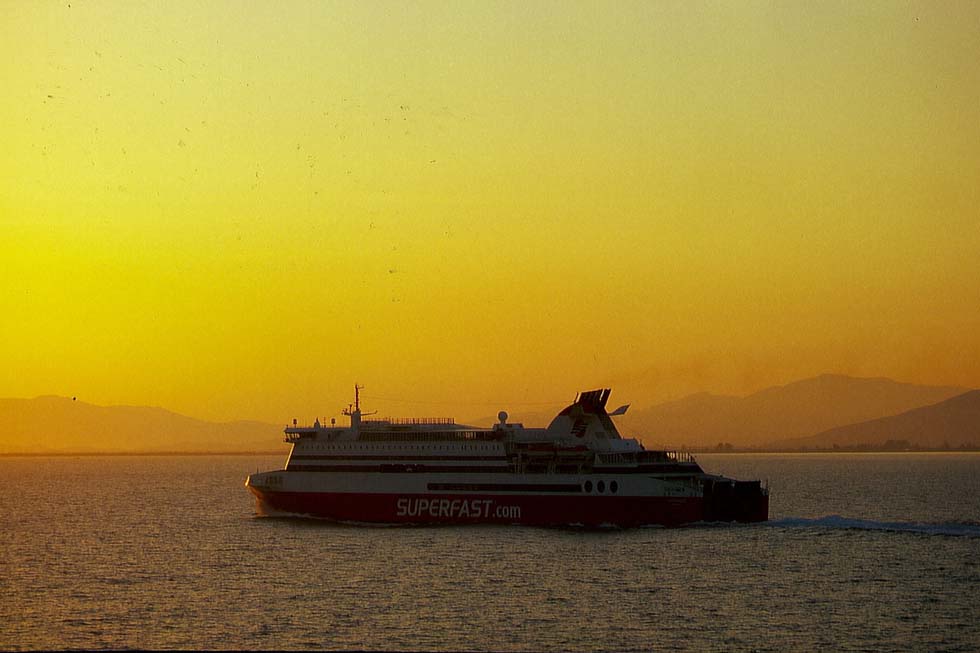
"Superfast XI" leaving Patras (WS)
|